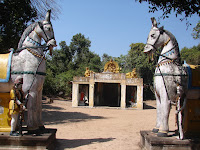Sacred forests of Coastal Tamil Nadu, India
Sacred forests of Coastal Tamil Nadu, India
Sacred groves or sacred forests are small/large forest patches, strictly protected on the traditional and religious backgrounds. Sacred groves are dedicated either to gods/animals or ancestral spirits which are governed largely by the local communities over years. The existence of sacred groves are reported across the world and in India, more than one-lakh groves have been reported. In recent times, the concept of sacred forests is gaining importance, owing to their rich biodiversity. Since, these places largely remain free from anthropogenic pressure, they are even quoted as the "repositories" of many endangered and threatened species.
In Tamil Nadu, this concept is more prevalent in the coastal districts viz., Villupuram, Cuddalore, Nagapattinam, Pudukottai and Sivagangai, where more than 100 sacred groves are distributed as small patches ranging from 0.5 ha to 50 ha. Most places are governed by the local communities and very few sites like Puthupet sacred grove in Villupuram district are under Hindu Religious and Charitable Endowments Board. Nevertheless, the cultural and traditional values are followed strictly in most places, especially in Pudukottai district where people are not supposed to touch even the fallen twigs of trees. The temple size
inside the grove vary from very small to large concrete structures and is
also associated with terracotta horses. Since most of the sacred forest sites are community-managed,
the exhibition of group identity and
solidarity could also be evidenced. In many places, only the Caste-Hindus are allowed to enter the grove and we could also witness restrictions for women in few groves in Cuddalore and Pudukottai. The social
catchment area of each grove ranges from their respective taluks to districts.
For sites such as Puthupet the patronage ranges from one km vicinity to as far
as 150 km. Sacred groves widely attract people from far distances only at the
time of annual rituals. Annual rituals are usually associated with folk songs
and dance (koothu). In Sendhirakillai, a place near Chidambaram over 20,000 people gather on
annual function called “Lakshadeepam” (lighting one lakh mud lamps on either
side of mud road from the entrance of the grove to the main temple structure)
organized annually on a Friday in the second week of February. Similarly in Puthupet, more than one lakh people gather during annual festival.
 |
| Lakshadeepam function at Sendhirakillai |
The residing deities, Ayyanar/Muni/Karuppan or Amman are considered responsible for the well-being of the children, crops and cattle. For the
local people, from birth to death, there are several rituals associated
with sacred groves which have become an integral part of their lives. However, in recent times, the deterioration in the belief system, largely due to modernization has weakened the concept of sacred forests. For instance, small temple structures are slowly replaced by the giant concrete structures in many places. Encroaching the forest land for agriculture and road construction is also posing a major threat to these small patches of model forests. We recommend the suitable action plan for protecting these small forest patches which are in the verge of disappearance in some places.

Comments
Post a Comment